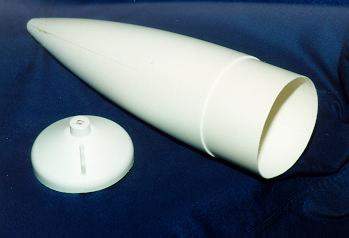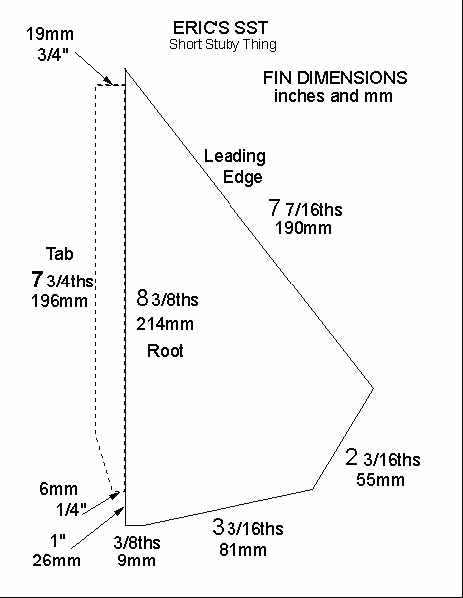Descon 4 Eric's SST Original Design / Scratch Built
Scratch - Eric's SST {Scratch}
Contributed by Steve Bloom
| Manufacturer: | Scratch |
Eric needed a new rocket. Earlier in the month I had launched his Lil’ Nuke on an H128 and it vanished. I told him we could buy a new one or he could design a rocket. He likes short stubby rockets like the Minie Magg and Fat Boy and since I couldn’t afford a Warlock he designed this:
It’s built using LOC Precision components. The construction is straight forward, basic, and sturdy. The rocket is designed to fly on an G64 through J350. This would make a nice starter kit for someone who is wanting to expand beyond the low and mid power kits available.
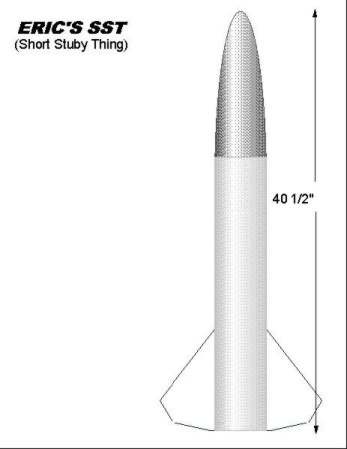
CONSTRUCTION
Body Tube (BT)
The 21 1/2" BT needs to be slotted for the fins. Marking the BT is easy. Tape 2 sheets of notebook paper together lengthwise to make one sheet about 14 inches long. From the 8 1/2 inch edge, measure two marks; One at 107mm and one at 214mm. Wrap this long sheet around the BT so the edges line up perfectly around the circumference. Now transfer the marks, including the paper edge to the BT. The end of the paper and the two marks should all be 107mm from each other.
To cut the slots we utilized a length of angle stock to draw straight lines and use as a cutting guide. I taped the angle to the BT and then used a very sharp x-acto to make the tube slots. The slots are 7 3/4 inches long and 1/8th wide starting at 1 inch from the bottom of the BT.
The fins are through the wall (TTW) but do not extend to the motor mount. We were using a set of Minie Magg fins from a kit of leftover parts. (Crash repair) The fins are locked into the centering rings and are very sturdy. First slide the CR’s into the BT and make marks through the fin slots onto the edge of the CR’s. Also, make an index mark on the BT and both CR’s so they can be oriented the same way in the future. On the upper CR, cut slots 8mm deep the same thickness as the fin material (1/8th in.) On the fins cut slots 8mm deep and 1/8th in. wide at 1 inch from the top of the tab. (see photo) |
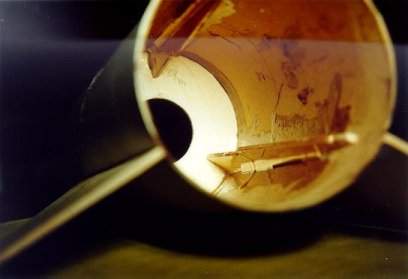 |
Now, bond the upper CR into the BT. I used Elmer's Yellow Wood Glue for all the CR bonds. Glue the fins to the upper CR to locate it evenly and hold it in place while the upper surface fillet dries. Turn the rocket over and apply a fillet to the lower side of the CR.
Time to think of motor retention: Drill two 3/16 holes, one on either side of the motor hole (1/4 - 1/2 inch away) in the aft CR. Apply a small amount of CA to the wood surface and in the hole. Seat the "T-nuts", 6/32 x 1/4, into the upper surface of the CR.
The fins require internal fillets for strength. (see photo) I found tiny molding at the hobby store but small scraps of balsa (1/8 x 1/8 x 6 in.) would work just as well. Bond these strips to the fins and BT to form a structural fillet. When this is complete the MMT and aft CR can be installed. Cut slots in the aft CR to capture the fin tabs. The slots need to be as deep as the fin tab sticks through the BT wall at the very bottom. Smear glue on the inside edge of the motor hole on the upper CR and on the MMT near the top. Start the aft CR onto the MMT (at the bottom end, not the glued end) and insert this as a unit into the upper CR. Push the MMT through the upper CR. Seat the lower CR into the BT until it hits the fins. (DO NOT ENGAGE THE SLOTS) Push the MMT up until it’s only protruding down 1/4 inch from the lower CR. Let the rocket dry upside down, this will form the fillet on the upper CR, lower side. (If you put on enough glue)
Now the aft CR can be removed with a wire hook in the fin slot hole. Smear glue on the MMT, BT, fin tabs and some on both edges (inner and outer) of the aft CR. Slide the aft CR into place, engaging the fin tabs in the slots. Let the rocket stand upright to form fillets on the upper surface of the aft CR. Later, apply fillets to the bottom of the aft CR at the BT and MMT.
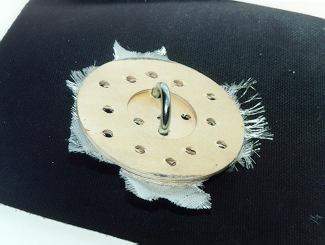 |
I use 9/16" wide tubular nylon webbing, stock no. 472315 purchased on-line from REI for the shock cord. 12 - 20 feet is about right. Attach it to the lower anchor with a quick-link. Attach the chute near the middle but not exactly (off 2 feet) with a quick-link attached to a loop tied into the tubular.
Use a big one. Really, your rocket should weigh about 36 oz. Start with a G80-4 SU or a G64-4 RMS, both 29mm. An adapter is required to use 29mm motors. (see photo) With the motor installed, get an idea of how big to form the retainer hooks. Bend the wire around the end of your needle nose (pliers) to form a tight loop, just big enough to encircle a 6/32 screw. Bend it up at nearly a 90 degree and then form a hook which will capture the engine. Repeat for opposite side. (See photo) The calculated center of pressure (CP) is 24.68 inches from the tip of the nose. This puts it at 1 inch ahead of the fins where they attach to the BT. With an I211 loaded in the rocket there is just less than 1 dia. stability. It should fly perfect on anything less that has enough power. The launch report (from LDRS) will tell how well it does on a J350. Oh yeah, don't forget the launch lug! |
Finished Rocket
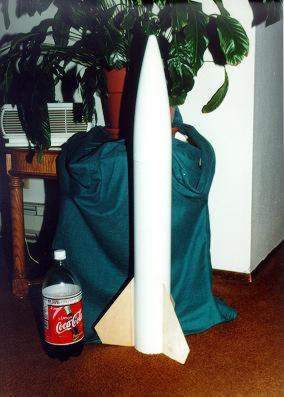
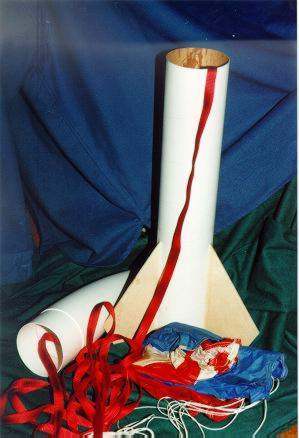
LAUNCH REPORT:
Wednesday, November 18th, 1998
Snohomish River Valley, Everett, WA
55 degrees f, gentle southerly breeze of 5 knots
Noonish
The weather was going to cooperate and Eric had only a half day of school. He assembled the RMS G64-4 while I loaded the truck and we were off. The rocket sat on the pad for a minute while we cleared an airplane and then it was off with a roar. Perfect boost with no weather cock to about 800 feet. The 4 sec delay was right on as the chute was expelled just as the rocket reached apogee and tipped over to horizontal. It came down as expected with the nose cone touching down first in the soft dirt. It landed squarely on the base so the fins are not going to be prone to damage. It's just begging for=more power. I've got a couple of I211's to use and we will if the weather holds for our waivered launch in Monroe in a few weeks.
| Body Tube, BT 3.90 (21 1/2"L) | LOC Precision | $6.32 |
| Fin Stock, 1/8 Ply Sheet (10 x 14) | Hobby Store | $7.00 |
| Nose Cone, PNC 3.90 | LOC Precision | $12.56 |
| Motor Mount Tube, MMT 1.52(38mm) | LOC Precision | $3.84 |
| Centering Rings (2) CR 3.90-1.52 | LOC Precision | $4.00 |
| Eye Bolts, 1/4" (2) | Hardware Store | $2.00 |
| Washers (1) large, (1) small | Hardware Store | $0.12 |
| Tubular Nylon, 9/16" (20 feet) | REI (stock #472315) | $4.40 |
| Parachute (28") LP28 | LOC Precision | $8.29 |
| Launch Lug, 1/2" LL.50 | LOC Precision | $0.50 |
| "T" Nuts 1/4 x 6/32 (2) | Hardware Store | $0.67 |
| Motor Adapter, MMA-2 | LOC Precision | $2.59 |
| Motor Hooks, 10ga bare copper wire | Hardware Store | $0.28 |
| Total $52.63 |
 |
 |
